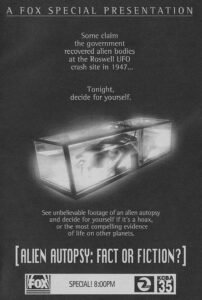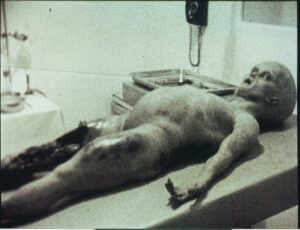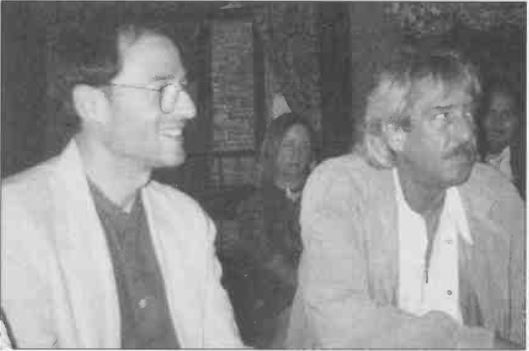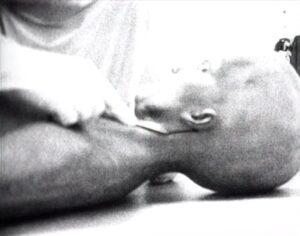The idea that there are visitors to the planet, that they are not only visiting now but have been visiting since prehistory, and how it affects us is a very interesting idea. I suppose, just looking up into the night sky at all those millions of stars up there, you wonder if it’s possible. I have a pet theory that everyone wants to have that experience where they’re driving down a desert road at night, and they see something and can’t explain what it is. I think it’s all about religion. Not necessarily Christian religion, but it’s about beliefs — and meaning and truth and why are we here and why are they here and who’s lying to us. Encountering a UFO would be like witnessing a miracle.
— Chris Carter, creator of The X-Files
In July of 1993 — or maybe it was 1992 — a British music archivist named Ray Santilli traveled to Cleveland, Ohio, a city which had been a hotbed of early rock and roll three and a half decades previously, hosting concerts by everyone from Bill Haley to Elvis Presley. Now, Santilli was hoping to unearth some buried treasures of that era for the sake of posterity and profit: audio recordings, pictures, or, best of all if possible, video footage of one of the most important cultural movements of the twentieth century in its nascent stage.
Santilli put an announcement in a local newspaper, explaining who he was and what he had come for, dangling the prospect of generous compensation for any artifacts that fit the bill. Amidst a lot of dross and false leads, he received a call from a fellow whose 82-year-old father, so the caller claimed, had just what the energetic Briton dreamed of finding here in the American heartland. The elderly man in question, whom Santilli would later identify only as “Jack B.,” had worked a big open-air concert in Cleveland in 1957 as a cameraman. While some of the footage he had shot there was already a part of the public record, he had some additional reels of heretofore unseen film stashed in his attic in Florida, the state to which he had retired some years ago.
Santilli secured an invitation to visit Jack in Florida the next time he came to the United States; luckily, this was to happen in just a few months. When he arrived at the former cameraman’s snug little home, he was gratified to learn that his host was a straight shooter. Just as promised, Jack produced footage of a lean and hungry Elvis Presley giving the staid America of the Eisenhower era a good solid rocking and rolling. The transaction was quickly concluded: Santilli handed Jack a wad of cash, and Jack handed over the film, which Santilli would go on to include in a videotape compilation of early Elvis and Johnny Cash concert performances.
He was packing his suitcase in his hotel room the next morning, feeling quite pleased with himself at having gotten what he had come for, when Jack unexpectedly rang him up again. “Ray, are you interested in other material as well?” asked the old man at the other end of the line. Santilli said cautiously that he might be, depending on what it was. “Then come over here again,” said Jack. “I have something here that may be even more interesting than the Elvis film.”
Intrigued despite himself, Santilli swung by the house on his way to the airport. Jack sat him down on the couch and pointed to a raggedy cardboard box that sat on the living-room floor. It was full of 16-millimeter film canisters. “Ray, have you ever heard of the Roswell incident?” asked Jack. Santilli shook his head. “Well,” said Jack, “a UFO crashed in the desert near Roswell, New Mexico, in 1947. I filmed the salvaging.”
Jack went on to explain that he had been drafted into the United States Army during the Second World War, but that a childhood bout with polio had rendered him unfit for combat duty in the eyes of the military. Instead he had worked as a cameraman for the Army during and after the war; he hadn’t left the service until 1952. During his near-decade in uniform, he had filmed various top-secret projects and tests, including the very first explosion of an atomic bomb in another part of the New Mexico desert. But nothing compared to the day in 1947 when he was sent to Roswell to document everything that was going on there. He filmed extensively at the crash site of the UFO. And then he was flown to a military base near Dallas, Texas, to film the autopsies of two alien corpses that had been recovered from the wreckage. This was the footage that he had been storing in his attic all this time. According to him, the Army had simply forgotten to send anyone around to pick it up. Now, at long last, he had decided to sell it, in order to pay for a big wedding for his favorite granddaughter. He wanted $150,000 in cash — “owing to the taxes, you know. You get the film. I get the money. And you tell nobody where you got the film from.”
Santilli told Jack that he wasn’t the sort of person to buy anything sight unseen. Acceding to the wisdom of this policy, Jack set up the same projector on which they had watched Elvis’s gyrations the day before, pulled the curtains down over the windows, and started the machine clack-clacking into motion. On a clear patch of wall in front of him, Santilli saw the flickering images that would transfix the world a couple of years later. A humanoid but plainly inhuman corpse lay on a bare metal table. It had a bulbous head and eyes and a shrunken, childlike body with a distended belly that caused him to wonder if it was pregnant. It had two arms and two legs, but six fingers on each hand and six toes on each foot. It appeared to be completely hairless, its skin vaguely fish-like in pallor and texture. Two presumably human doctors, their faces hidden beneath the hooded contamination suits they wore, examined and then cut the body open while a third man in a face mask looked on from behind a pane of safety glass.
Passionate about music though he was, Santilli recognized immediately that this was more important — and vastly more valuable — than all of the lost rock-and-roll footage in the world combined. If, that is, it really was what Jack claimed it to be.
The reels were stamped with the Kodak name. So, Santilli placed a call right then and there to that company’s headquarters in Rochester, New York, and asked to be forwarded to the records department. “I have some old 16-millimeter film which is supposed to date back to 1947,” he said to the man who came on the line. “How can I tell whether this is true?”
“We have a simple system for that,” answered the man from Kodak. “There should be a geometric code on the edge of the film. What symbols do you see there?”
“A square and a triangle,” said Santilli.
“Good. Just a moment… yes, that was 1947.”
Santilli was satisfied. Unfortunately, though, he wasn’t a wealthy man; he certainly didn’t have $150,000 in his pocket to hand to give to Jack there and then. Telling the old man that he would get in touch again just as soon as he could, he flew home to London to start beating the bushes for the funds.
It proved harder to raise the money than he had ever anticipated. Even leaving aside how absurd this claim of an alien-autopsy film sounded on the face of it, few would have been eager under any circumstances to pony up $150,000 for a source whose real identity they didn’t even know, for a piece of merchandise that only Santilli himself had seen. Convinced that he was on the cusp of a coup that would make the revelations of Bob Woodward and Carl Bernstein seem like small potatoes, Santilli called every number in his Rolodex in a near panic. For he knew that Jack’s health was not particularly good, and he lived in fear that the old man would die on him before he could come up with the money. Nonetheless, it wasn’t until November of 1994 that he was able to convince a German music producer named Volker Spielberg to finance the purchase. That same month, Santilli made the round trip to Florida again, returning this time with the 22 reels of film in his luggage.
Being nearly 50 years old and having been stored in less than ideal conditions throughout that time, many of the reels were in extremely bad shape. Santilli therefore sent them first to a conservator, to be restored as much as possible and then copied onto other media for long-term preservation. Once that had been done, it was finally time to announce the film’s existence to the world.
On March 11, 1995, Santilli invited to a London movie theater a bizarre cross-section of public figures: serious journalists along with not-so-serious entertainers; prominent UFO believers along with skeptics; noted scientists along with representatives of most of the world’s major religious faiths; even the former head of the British Ministry of Defence’s controversial, recently concluded “UFO Project.” That project had declared in its final summary that it could find no evidence that extraterrestrials had ever visited our planet, much less that any terrestrial government had conspired to cover up such an event. Perhaps its director would now feel compelled to revisit the matter.
Or maybe not. “The result [of the first screening] was absolute, total rejection,” lamented Santilli later on. “They all considered it a swindle. Some even left in the middle of the show.”
Undaunted, Santilli kept right on knocking on doors. Most of the news organizations he contacted wanted to do a full forensic examination of the film before they would agree to license it; this Santilli did not wish to allow. Rupert Murdoch, however, was not so scrupulous.
Already at that time, Murdoch was the worldwide king of tabloid journalism and much else in mass media besides. He was by then well along in the process of building a staggering fortune out of the understanding that many or most consumers of “news” don’t want objective facts; they want news that will entertain them, at the same time that it confirms the worldviews to which they are most predisposed. His fortune would only continue to grow over the decades to come, as he continued to put this understanding into ruthless practice.
Murdoch came out of a private screening of the alien-autopsy film knowing that he simply had to have it. He prepared a contract which made Santilli and his largely silent partner Volker Spielberg rich men overnight. Then he made plans to show the film to maximum advantage all over the world — including in the biggest media market of them all, the country of its alleged origin. He passed the film to Robert Kiviat, the coordinating producer of an American “documentary” series called Encounters. Airing on Murdoch’s young and scrappy Fox television network, Encounters dealt in alien abductions, crop circles, ghosts, Bigfoot, and similar paranormal and/or conspiratorial fodder.
On Tuesday, August 28, 1995, Fox broadcast a program called Alien Autopsy: Fact or Fiction?, whose one-hour running time — or rather 45 minutes with commercials — included about four of the nineteen and a half minutes of footage which Santilli had provided to Murdoch. The balance of the time was spent talking about the film, plus the long-rumored UFO crash at Roswell whose veracity it might prove.
The host of the program was Jonathan Frakes, the actor who had played Commander Will Riker of the starship Enterprise on the recently concluded television series Star Trek: The Next Generation, and was thereby presumed to have some special insight into aliens from outer space. Although the title of the show seemed to describe it as an inquiry into the authenticity of the film, the affirmative case was given a lot more air time than the negative. “It was not what you would expect from a major network that thought it was broadcasting a history-making film,” noted the magazine Skeptical Inquirer later on. “It was, however, what you would expect from a network trying very hard not to spoil an illusion.” The show’s field director, John Jopson, claims today that he was told in no uncertain terms to can it when he persisted in asking too many questions of Ray Santilli. “Cut the Perry Mason act and finish the show,” is what he says that Robert Kiviat told him. “It was made clear to me that, if the footage was exposed as a hoax, the ratings would suffer,” he elaborates. (Kiviat denies that these exchanges ever took place.)
In place of a hard-hitting interrogation of Santilli, an expert from Kodak testified that the film stock appeared to stem from 1927, 1947, or 1967 (it turned out that the geometric codes were periodically reused); a former military cameraman who had worked during the same era as Jack B. testified that the film was consistent with the equipment and shooting techniques he had employed; the prominent pathologist Cyril Wecht testified that the men seen performing the autopsy in the film were, judging from the procedures they followed, “either [themselves] pathologists or surgeons who have done a fair number of autopsies”; the Hollywood special-effects guru Stan Winston testified that “my hats are off to the people who created it — or [to] the poor alien who is dead on the table.”
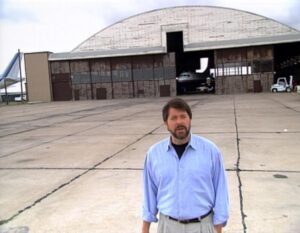
Like his fellow Star Trek alumnus William Shatner before him, Jonathan Frakes wasn’t one to look the gift horse of a paying gig in the mouth. “Patrick Stewart turns all this shit down,” he told journalist Emily Nussbaum decades later. “Because I’m such a whore, I took this, and the producer hired me for another couple of jobs.” He even became an executive producer and occasional guest star on a scripted television series called… you guessed it, Roswell.
The program proved every bit the cultural bombshell and ratings bonanza Rupert Murdoch had thought it could be. It became the most-watched show in its time slot that evening, a major achievement for Fox, which normally still lagged well behind CBS, NBC, and ABC, the older “Big Three” American networks. From one day to the next, the water-cooler discourse in the country switched from such comparatively prosaic matters as the Oklahoma City bombing and the O.J. Simpson murder trial to aliens and UFOs and Roswell, Roswell, Roswell. The demand from those who had missed the program’s first airing was so enormous that Fox showed it again a week later, with three precious additional minutes of footage from the film appended onto the end. Even more households tuned in to watch this encore.
Meanwhile Murdoch was using his far-flung media empire to bring the same show to other markets, with much the same results. The buzz eventually reached all the way to the ears of the most powerful man in the world. On November 30, 1995, during a state visit to Northern Ireland, President Bill Clinton was asked by a twelve-year-old boy what he knew about Roswell and the alien-autopsy film. Cracking an awkward smile, he answered, “If the United States Air Force did recover alien bodies, they didn’t tell me about it.”
Skeptical voices had a hard time cutting through the excitement. Even they had to acknowledge that, if it was a fake, the film wasn’t an entirely inept or thoughtless one. For example, the clock and the telephone that could be seen on the wall of the examination room, even the metal tray used to hold the doctors’ saws and scalpels, were period correct.
All the same, there were some serious discordances to be espied as well, discordances which only became clearer once it was possible to view all nineteen and a half minutes at once on the inevitable home-video release. “Ufologists” wondered why the aliens in the film didn’t fully agree with the eye-witness accounts of people who had supposedly seen the bodies after the crash at Roswell; their aliens had no ears and four fingers, whereas these ones had small ears and six fingers. Scientists wondered at the strange suits worn by the doctors, which could have protected them from neither radiation nor biological contaminants; the one useful purpose they did seem to serve was to conceal the faces and thus the identities of the doctors themselves. And then, you didn’t have to be a ufologist or a scientist to wonder why an historic event such as this one would have had only four witnesses including the cameraman, why the autopsy was done as if everyone involved had someplace else he urgently needed to be in an hour or so, and why the cameraman was so gosh-darned bad at his job, allowing his camera to go out of focus and stay that way every time he zoomed in for a closeup.
For that matter, where was the cameraman anyway? Even if Ray Santilli himself refused to share any further information — thus honoring, so he said, the promise of anonymity which he had made to the old man — couldn’t any competent private investigator track down a man in his mid-eighties who currently lived in Florida, had formerly lived in Ohio, had contracted polio as a child, and had been drafted into the Army during the Second World War and continued to serve until 1952? Many investigators tried, but none could locate him.
To make matters worse, the details of Santilli’s story kept changing, much to the dismay of those who craved just one set of facts to check. For example, as I alluded to at the beginning of this article, sometimes it was 1992 and sometimes 1993 when he first encountered the film. His story wasn’t even internally consistent when you really stopped to think about it. Why was Jack B. worried about taxes when he expected to be paid under the table with a proverbial unmarked envelope full of cash?
More information emerged from Kodak, revealing that the film they had examined had consisted only of five frames of blank leader, a tiny snippet of celluloid which could have come from anywhere: “Sure, it could be an old film, but it doesn’t mean it is what the aliens were filmed on.”
Arguably the most devastating criticisms came from a legion of pathologists, who, in marked contrast to their credulous colleagues on the Fox special, saw all sorts of oddities and inconsistencies in the footage.[1]It turned out that Cyril Wecht, Fox’s chosen pathologist, had a penchant for conspiracy theories long before the alien-autopsy special was aired. In 1978, he was one of four pathologists who were allowed to reexamine all of the material gathered during the John F. Kennedy autopsy; he was the only one who insisted that the president’s wounds were inconsistent with the conclusion of the Warren Commission that there had been only one shooter. He went on to write several books on the subject, and served as a consultant to Oliver Stone’s 1991 movie JFK, which pushed the theory of an inside job by the CIA. They said that the doctors held their instruments awkwardly and seemed to have no method whatsoever to their madness, making random slices and scooping out the aliens’ organs willy-nilly. Speaking of which: the aliens themselves seemed more like grotty Halloween piñatas than formerly living organisms, mere sacks filled with amorphous lumps of viscera. “I cannot fathom that an alien who had external organs so much like ours could not have some sort of definitive structural organs internally,” said one pathologist by the name of Ed Uthman. Similarly, special-effects experts — the ones not contacted by Fox — said that, while the film was not a terrible fake by any means, these dead aliens were nevertheless well within the scope of their craft to provide to a filmmaker of even modest means. Based on testimony like this, even many ardent ufologists became convinced that the film was a fraud, possibly deliberately planted by a government that was eager to discredit their avocation.
Finally, there was the central absurdity that always dogged all of the talk of Roswell: that these aliens had made their way to Earth over distances of which the human mind can scarcely conceive, avoiding meteors and black holes and all sorts of other cosmic perils that are equally far removed from our capability to even imagine, only to get a stray pigeon or something stuck in their spaceship’s engine grille and wipe out in some farmer’s field. It could happen, one had to assume, but boy, did the odds seem stacked against it.
Despite all of these commonsense objections, the public consensus that the film was as likely real as not held for quite some time across much of the Western world. Interestingly, the one outlier here was Germany, a country which had lived through another embarrassing hoax at the beginning of the previous decade, when a rogue journalist from the respected magazine Stern and an underworld document forger had produced a set of purported diaries written by Adolf Hitler that had equally entranced the world. Call it a case of once bitten, twice shy; both Stern and its arch-rival Der Spiegel came out stridently against the film’s authenticity from the start. Obviously relishing the chance to pour a bit more salt into an old wound, Der Spiegel explicitly called the alien-autopsy film the 1990s equivalent to the Hitler diaries. Stern didn’t go quite that far, but it did roundly chastise the film’s peddlers. “If you want to fool us, you have to try a little harder,” it wrote with the hard-won wisdom of experience.
The Germans and the other skeptics were right, of course. The origin story I passed on to you at the beginning of this article — at least everything after Santilli’s acquisition of his footage of Elvis Presley in concert — is a complete lie. Facing increasing pressure to explain the many aspects of his story that didn’t fully make sense, Santilli committed a blatant self-own in 1997, when he showed pictures of the canisters in which, so he claimed, the film had been stored when he acquired it. (He was still refusing to provide the artifacts themselves for forensic examination.) The canisters were neatly labeled, “Property of the Department of Defense.” But, sadly for him, no agency of the American government had yet existed under that name at the time the autopsy was supposed to have been conducted.
And so the fever dream broke. Switching tacks without missing a beat, Fox in 1998 included the film in a television special called World’s Greatest Hoaxes, as if they had had nothing to do with this hoax’s dissemination. The producer and mastermind of that show was… Robert Kiviat, the man behind the original alien-autopsy special. You can’t make this stuff up.
In 2004, long after the cultural moment that had produced the alien-autopsy sensation had passed into history, Ray Santilli finally came clean — partially, at any rate. He admitted to the British television presenter Eamonn Holmes that he and a few friends had faked the film in a vacant London flat, using “aliens” that had been made out of plaster and stuffed with sheep brains, chicken entrails, and other assorted offal picked up at a local butcher shop. (The smell in the apartment, the hoaxers said, was “horrendous.”) After the filming was complete, they had cut what was left of the aliens up into small pieces and dropped them into dumpsters all over the city, as you do when you’re looking to hide the evidence of a crime.
Plainly worried about his legal exposure for perpetrating this fraud that had made him a millionaire, Santilli hedged his bets by insisting that he really had bought an alien-autopsy film from Jack B. in Florida, but that the reels that held it had literally crumbled into dust within a few days of being exposed to the air in London. (Was pollution particularly bad that year?) The film he had sold to Rupert Murdoch had been a “reconstruction” of what he had seen on the original reels. “It’s no different from restoring a work of art like the Mona Lisa,” he insisted. This might be true — if, that is, an art restorer’s job involved painting from scratch a new version of a work he had once glimpsed briefly, then passing it off as the original. As it is, this process goes by the alternative name of “forgery” in most circles. Even Santilli could hardly keep a straight face as he spouted this nonsense to a wide-eyed Eamonn Holmes. His tell is his smirk.
The reason Santilli suddenly decided at this late date to share even this much of the truth is equally plain. A new scripted cinema film was in the offing, entitled simply Alien Autopsy, telling a heavily fictionalized, comedic version of his story. There was now more money to be made from the truth than from the lie, in other words.
Since then, the forgery that made Santilli rich has well and truly passed into history as a classic piece of 1990s kitsch. Der Spiegel was correct; the alien-autopsy film did indeed become the 1990s’ closest equivalent to the Hitler diaries, complete with the same “what the hell was everyone thinking?” quality when looked back upon from the perspective of posterity. Unlike the two main perpetrators of that fraud, both of whom did time in West German prisons, Ray Santilli and his partners have never suffered any legal or financial consequences for their actions. For all that far worse criminals have gone equally unpunished, one still can’t help but feel that there is some injustice in this. The fact is, however, that Rupert Murdoch’s operation had no reason to pursue the matter. They had gotten many times their purchase price out of the film, whose authenticity had never been of any real concern to them. Only the rubes were duped. Ah, well… at least the 2006 cinema film was a flop. Its subject matter felt as outmoded by then as grunge music and Britpop.
Today only the most committed of UFO evangelists still believe in the original alien-autopsy film. Getting the burden of proof hopelessly muddled, these folks now demand that Santilli substantiate not his old claim that the film is genuine but his new one that he faked it. Naturally, his ongoing failure to do so demonstrates that he must have been intimidated by shadowy government agents into concocting the bogus tale of forgery. There’s something touching about people who want to believe so very, very badly, people for whom aliens have become a sort of religion.
To the jaded eyes of the rest of us, on the other hand, the conspiracy theories of the 1990s now seem charmingly quaint. We might even be tempted to see them as proof of an axiom that, when we humans lack sufficient stuff to worry about, we invent worries to fill that space. In a time when North America and Western Europe were at peace, were as wealthy as they had ever been, and seemed to have definitively demonstrated that liberal democracy and free markets were political perfection achieved — “the end of history,” as Francis Fukuyama so infamously put it — what else was there to satisfy their citizens’ need to worry than alien abductions, alien technologies, and a myriad of equally improbable government conspiracies surrounding it all? Then, as soon as September 11, 2001, showed that history just keeps marching on and that we actually had had something substantive to worry about during the previous decade, if only we had recognized it, all of that stuff blew away like tinfoil hats in the wind.
For all that this point of view is inevitably oversimplified, I do feel like there’s a kernel of truth there. More unnerving, however, is the structural pattern of 1990s conspiracy theories, a pattern which has proved more enduring than their content. Like the tabloid-news outlets which did so much to feed them, they blurred the lines between entertainment and information. People believed them mostly, it seems to me, not so much because they needed something to worry about as because they were fun. It was fun to speculate about what the next layer of the onion might be, fun to feel oneself to be privy to so many secrets and lies. For many people, it was fun as well to have a longstanding suspicion that “the system” had always been out to get them confirmed. Despite all their nefarious deeds and actors, conspiracy theories, then as now, were a sort of comfort food, keeping the truly difficult questions in life and politics, which don’t tend to have such bright neon lines separating good from evil, firmly at bay.
When all was said and done, did their adherents during the 1990s really believe aliens were everywhere? From the outside, it was hard to say for any given individual — and maybe from the inside as well. Following the tales about Roswell and crop circles and human abductions and all the rest became a form of fandom, not that far removed from the fannish dissection of each new episode of, say, Twin Peaks — or of The X-Files.
Yes, we have finally arrived at the real elephant in this particular room. While the alien-autopsy film was only a blip on the pop-culture radar, grist for the mill of Jeopardy! and Trivial Pursuit in the decades that followed, The X-Files, which likewise aired on Rupert Murdoch’s young Fox television network, became a veritable way of life for its most committed fans. Its first episode was broadcast in September of 1993, two years before the alien-autopsy special. By popularizing the ideas of alien visitations and government conspiracies to conceal their existence — ideas which it did not invent, but which were largely confined to the cultural fringe prior to its arrival on the scene — it laid the groundwork for Ray Santilli’s hoax. Then it continued on for years after that bit of excitement had come and gone, to become not just a footnote to but an enduring icon of 1990s pop culture, guaranteed to appear on any top-ten list of the decade’s biggest hits.
“The X-Files is that rare show that seems to exist both in the time it aired and in the present,” notes Emily St. James, the coauthor of a recent book about the series. “It is, beyond all reason, timeless, despite being perhaps the ultimate TV show of the 1990s.” The X-Files changed the nature of television, the nature of popular entertainment writ large — and, for good or for ill, it also changed us, as people and as a people. A poll conducted by Time magazine and the news channel CNN in 1997 found that 64 percent of Americans believed that aliens were in the habit of visiting Earth. Absent The X-Files, the number would surely have been a small fraction of that size.
The story of The X-Files as a cultural phenomenon is something of a postmodern Gordian knot. The show borrowed much of its central mythology from fringe conspiracy theories. Then it went on to popularize such theories to such an extent that they could be introduced into the mainstream real-world discourse via organs like Ray Santilli’s film. And then, the show’s ongoing fiction began responding to the very same real-world currents which it itself had set in motion.
On November 24, 1995, just three months after the alien-autopsy special, Fox aired the X-Files episode “Nisei.” In it, FBI Agent Fox Mulder, the more credulous by far of the show’s two protagonists, has purchased an alien-autopsy film via mail order, prompting his more skeptical partner Dana Scully to complain that it is “even hokier than the one that aired on the Fox network.” (Her skepticism is ill-founded: in the universe of the show, the footage is real.) To provide the final dollop of irony, the real-world Fox network ran commercials for yet another repeat showing of the alien-autopsy special during the episode in question. The world had never seen a feedback loop quite like this before. It was an early example of a weird hyper-reality that has since become commonplace, such that mediated experiences of all descriptions have become more subjectively real to many of us than the objectively real people and places around us.
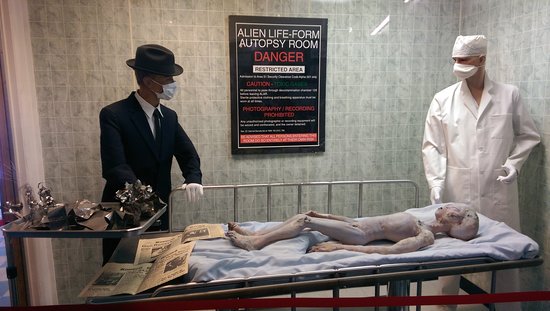
Another example of postmodern hyper-reality, from the grandiosely titled International UFO Museum and Research Center in Roswell, New Mexico. The biggest single exhibit in the place is a diorama which proudly depicts the scene in Santilli’s film, despite the fact that the latter has been so widely dismissed even by most ufologists. Is the museum meant to get at the truth of what happened in Roswell in 1947, or is it really about reveling in all the fantasies that have been spun from what was almost certainly a fallen espionage balloon? One senses that even the proprietors of the museum aren’t quite sure anymore. One thing only is crystal clear: that the museum and the town of Roswell make a lot of money from being the UFO capital of the world.
Next time, then, we will delve into the origin story of this other 1990s media artifact, whose influence was so pervasive throughout the decade — including in computer games, my usual beat around here. Take heart, for I can tell you that the truth is sometimes out there: this origin story will actually be true. Would I lie to you?
Did you enjoy this article? If so, please think about pitching in to help me make many more like it. You can pledge any amount you like.
Sources: The books UFO: The Inside Story of the US Government’s Search for Alien Life Here — and Out There by Garrett M. Graff; “Deny All Knowledge”: Reading the X-Files, edited by David Lavery, Angela Hague, and Marla Cartwright; The UFO Invasion: The Roswell Incident, Alien Abductions, and Government Coverups, edited by Kendrick Frazier, Barry Karr, and Joe Nickell; Beyond Roswell: The Alien Autopsy Film, Area 51, & the U.S. Government Coverup of UFOs by Michael Hesemann & Philip Mantle; The UFO Diaries: Travels in the Weird World of High Strangeness by Martin Plowman; Conspiracy Culture: From Kennedy to The X-Files by Peter Knight; Monsters of the Week: The Complete Critical Companion to The X-Files by Zack Handlen & Emily St. James; X-Files Confidential: The Unauthorized X-Philes Compendium by Ed Edwards, The Little Book of Aliens by Adam Frank, Cue the Sun!: The Invention of Reality TV by Emily Nussbaum, and Selling Hitler: The Classic Account of the Hitler Diaries by Robert Harris.
Online sources include Ray Santilli’s story of his acquisition of the alien-autopsy film at Aquarian Age Information Central and “How an Alien Autopsy Hoax Captured the World’s Imagination for a Decade” by Nathalie Lagerfeld at Time. Video sources include the 2004 episode of Eamonn Investigates in which Ray Santilli and friends finally come (partially) clean, the original Fox alien-autopsy special, and the full nineteen-minute alien-autopsy film.
Footnotes
| ↑1 | It turned out that Cyril Wecht, Fox’s chosen pathologist, had a penchant for conspiracy theories long before the alien-autopsy special was aired. In 1978, he was one of four pathologists who were allowed to reexamine all of the material gathered during the John F. Kennedy autopsy; he was the only one who insisted that the president’s wounds were inconsistent with the conclusion of the Warren Commission that there had been only one shooter. He went on to write several books on the subject, and served as a consultant to Oliver Stone’s 1991 movie JFK, which pushed the theory of an inside job by the CIA. |
|---|
